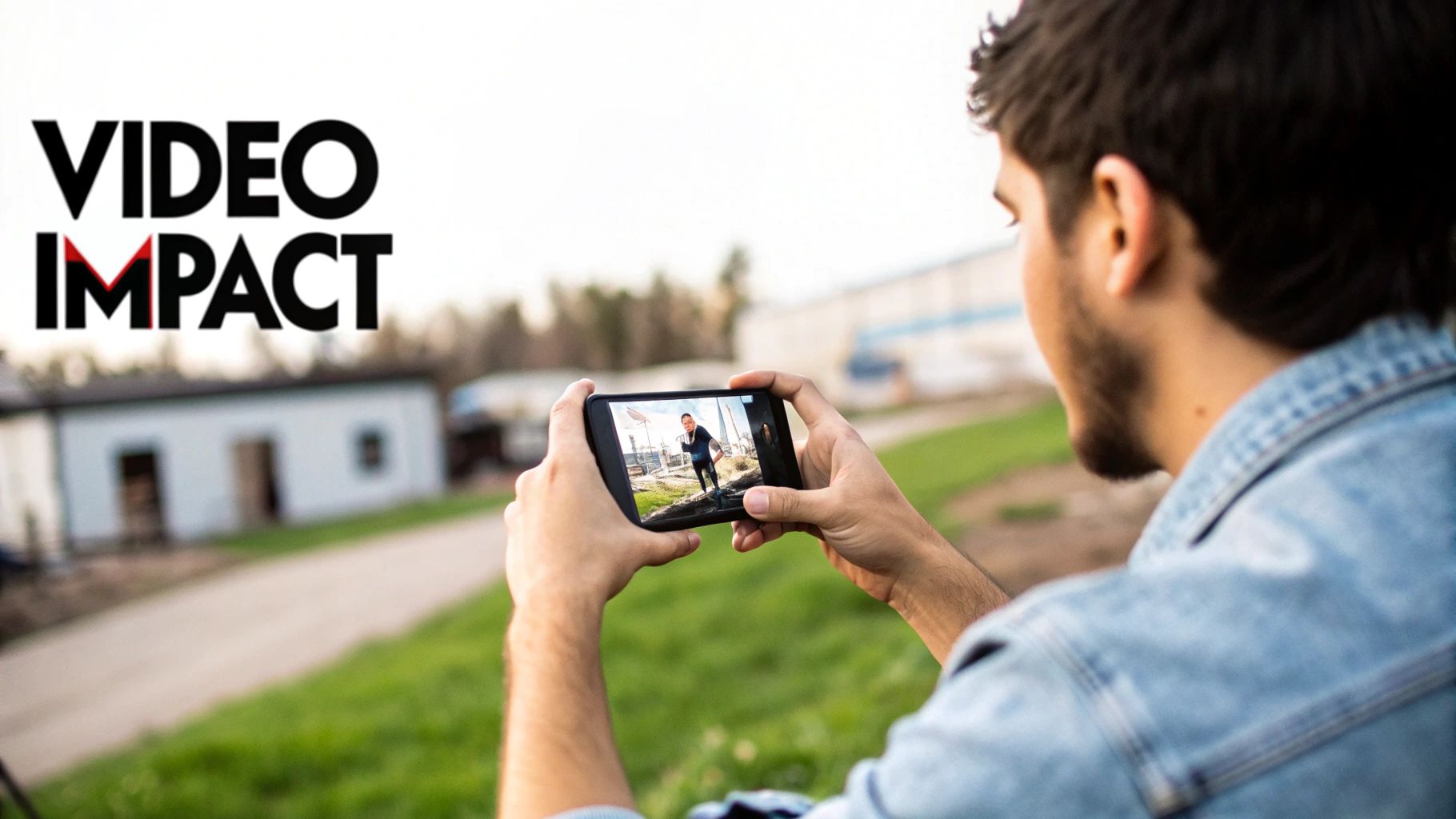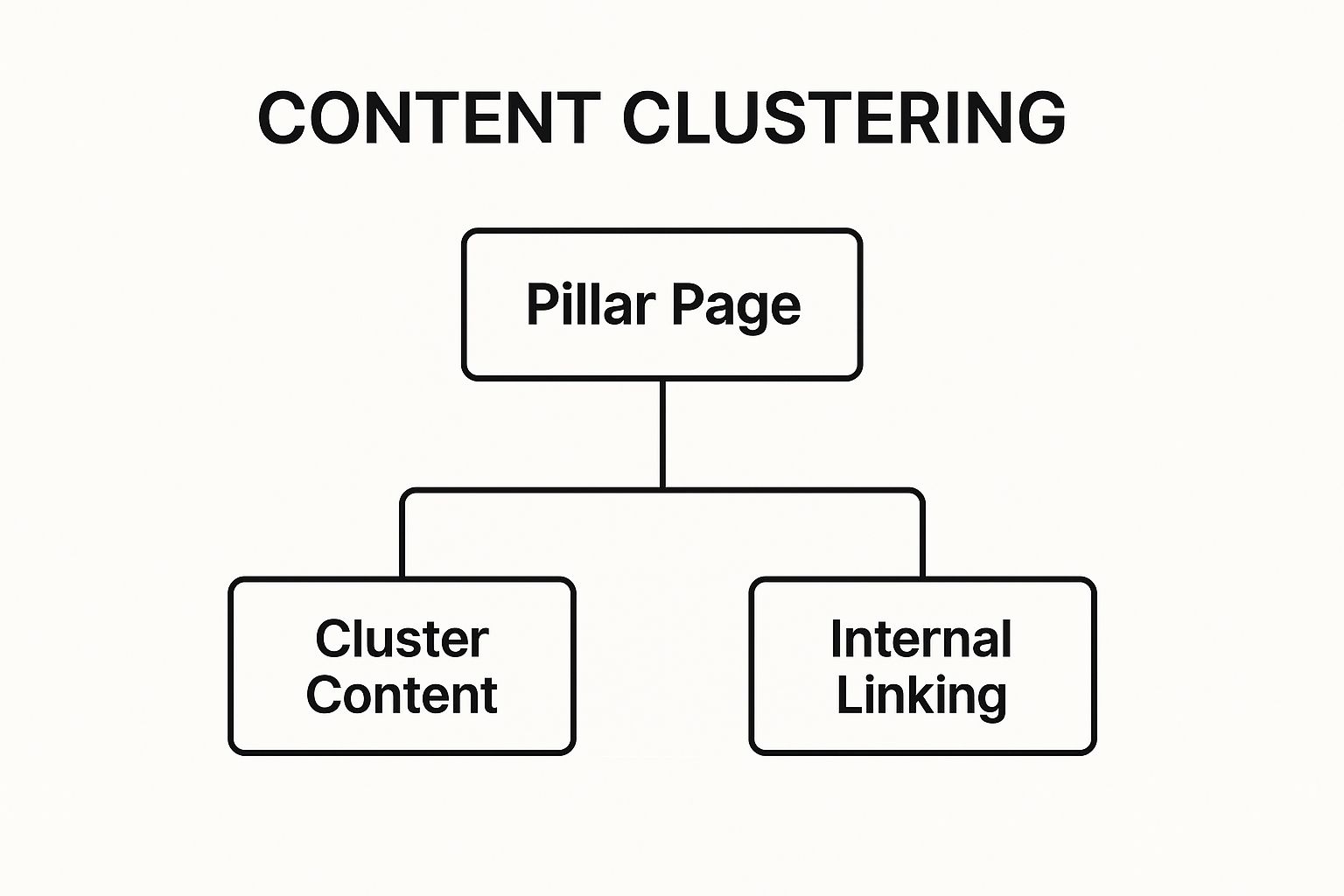Creating great content is only half the battle. To truly stand out and make an impact, you need a robust plan to maximize its reach and effectiveness. This is where powerful content optimization strategies come into play, transforming good content into high-performing assets that drive traffic, engage audiences, and achieve specific business goals. Without a clear optimization plan, even the most well-crafted article or video can fail to reach its intended audience and deliver a return on investment.
This guide moves beyond the basics to provide nine actionable strategies that will elevate your content's performance across SEO, social media, and direct user engagement. We'll explore a diverse set of tactics, from technical SEO and A/B testing to content repurposing and leveraging user-generated content. Whether you're a seasoned marketer or just starting, these proven methods will help you get the most value from every piece you publish, ensuring your hard work delivers measurable results. Let's dive into the techniques that separate stagnant content from strategic, high-impact success.
1. Search Engine Optimization (SEO)
Search Engine Optimization (SEO) is the foundational practice of refining your content so search engines like Google can easily find, understand, and rank it for relevant queries. It’s a core component of any effective content optimization strategy because it directly connects your material with an audience actively seeking solutions. SEO moves beyond simple writing; it involves a technical and strategic approach to make your content discoverable.

This process includes on-page elements like keyword integration and meta descriptions, off-page signals like backlinks, and technical aspects such as site speed and mobile-friendliness. When executed correctly, SEO drives consistent, high-intent organic traffic that can grow exponentially over time. For a deeper dive into the fundamentals, explore this comprehensive guide to blog Search Engine Optimization.
Actionable SEO Tips
To get started, focus on these high-impact tactics:
- Target User Intent, Not Just Keywords: Understand what a user is really looking for when they type in a query. Are they seeking information ("what is content marketing"), a direct purchase ("buy running shoes"), or a comparison ("Mailchimp vs. ConvertKit")? Structure your content to directly answer that underlying need.
- Optimize for Featured Snippets: Aim for "position zero" by clearly answering common questions near the top of your article. Use structured data and format your answers in lists, tables, or concise paragraphs to increase your chances of being featured.
- Leverage Long-Tail Keywords: Instead of competing for broad terms like "marketing," target more specific, lower-competition phrases like "content marketing strategies for small businesses." These keywords often have higher conversion rates because the search intent is much clearer.
- Monitor Core Web Vitals: Google prioritizes user experience. Ensure your page loads quickly, is interactive, and remains visually stable by regularly checking your Core Web Vitals report in Google Search Console.
2. Content Personalization
Content Personalization is a dynamic content optimization strategy that tailors experiences to individual users based on their behavior, preferences, and demographics. Instead of serving the same content to everyone, this approach uses data to deliver relevant material that resonates with specific audience segments. It transforms a one-size-fits-all interaction into a one-to-one conversation, dramatically increasing engagement and conversions.

Pioneered by platforms like Amazon and Netflix, personalization makes users feel understood and valued. For example, Amazon’s product recommendations are responsible for a significant portion of its revenue, while Spotify’s Discover Weekly playlists generate billions of streams by catering to individual music tastes. When users feel content is made just for them, they are far more likely to engage, trust your brand, and convert.
Actionable Personalization Tips
To effectively implement personalization, focus on these practical steps:
- Start with Basic Segmentation: Before diving into advanced one-to-one personalization, group your audience by key attributes like location, past purchases, or content topics they’ve engaged with. This is a manageable first step toward delivering more relevant experiences.
- Implement Fallback Content: Ensure that new or anonymous visitors receive a high-quality, generalized experience. This fallback content serves as a baseline while you gather the data needed for future personalization, preventing a poor first impression.
- Use Progressive Profiling: Avoid overwhelming new users with long forms. Instead, gather information gradually over time through subsequent interactions. Ask for a name and email first, then perhaps their company size or interests on their next visit.
- Respect User Privacy: Be transparent about the data you collect and how you use it. Providing clear privacy policies and easy opt-out options builds trust, which is essential for users to willingly share the information needed for personalization.
3. A/B Testing and Multivariate Testing
A/B testing is a data-driven method for comparing two versions of a piece of content to see which one performs better. By showing "Version A" to one group and "Version B" to another, you can definitively measure which headline, call-to-action (CTA), or image drives more engagement. Multivariate testing takes this a step further by testing multiple variables simultaneously to see which combination yields the best results.
This approach is one of the most powerful content optimization strategies because it removes guesswork and allows you to make decisions based on actual user behavior. Instead of assuming what your audience wants, you can use empirical data to refine every element for maximum impact. The goal is to make incremental improvements that lead to significant gains in conversions, sign-ups, or engagement over time.
Actionable Testing Tips
To integrate testing into your workflow, focus on these key principles:
- Test One Element at a Time: In an A/B test, change only one variable, such as the headline or the button color. This ensures you can attribute any change in performance directly to that specific element. Testing multiple variables at once makes it impossible to know what caused the outcome.
- Ensure Statistical Significance: Don’t end a test prematurely. You need enough data to be confident that the results aren't due to random chance. Most testing platforms will tell you when you've reached statistical significance, typically at a 95% confidence level.
- Prioritize High-Impact Elements: Start by testing elements that have the biggest potential impact on your goals. Focus on headlines, CTAs, hero images, and lead-in copy before moving on to smaller details like font size or minor wording changes.
- Run Tests for Full Business Cycles: Let your tests run long enough to account for daily and weekly fluctuations in user behavior. A test that only runs on a Monday might yield very different results than one that includes a weekend. A full week is often a good starting point.
4. Content Repurposing and Atomization
Content repurposing is a powerful strategy that involves transforming one core piece of content into multiple formats for distribution across various channels. This approach, often called "atomization," maximizes the return on your initial content investment by extending its reach and lifespan. Instead of constantly creating new material from scratch, you strategically break down a substantial asset, like a webinar or research report, into smaller, digestible pieces tailored for different platforms.
This method is one of the most efficient content optimization strategies because it allows you to connect with diverse audience segments that prefer different media formats. A single idea can fuel an entire campaign, from a detailed blog post to a series of social media videos, infographics, and podcast episodes. For a complete overview of this process, see these effective content repurposing strategies.
Actionable Repurposing Tips
To implement this strategy effectively, follow these steps:
- Establish a Content Hierarchy: Start with a "pillar" piece of content, such as a comprehensive guide, webinar, or keynote speech. From there, break it down into smaller "micro-content" like social media posts, quote graphics, short video clips, and email newsletter snippets.
- Adapt Content for Platform Nuances: Don't just copy and paste. Tailor the repurposed content to fit the native format and audience expectations of each platform. A professional insight on LinkedIn should be presented differently than a quick, engaging tip on TikTok.
- Maintain Core Message Consistency: While the format changes, the central message and value proposition should remain consistent across all repurposed assets. This reinforces your brand's authority and creates a cohesive user experience.
- Track Performance Across All Formats: Analyze which formats and channels generate the most engagement. This data will inform your future content optimization strategies, helping you focus on the most effective repurposing tactics for your audience.
5. User-Generated Content (UGC) Integration
User-Generated Content (UGC) integration is a powerful content optimization strategy that leverages material created by your audience. This includes customer reviews, social media posts, testimonials, and videos. By incorporating authentic content from real users, brands can build immense trust, boost engagement, and create a powerful sense of community. UGC acts as social proof, validating your product or service in a way that branded content never can.
This approach transforms your audience from passive consumers into active brand advocates. Campaigns like Coca-Cola's 'Share a Coke' or GoPro's customer-shot video library are prime examples of how UGC can fuel marketing efforts and generate authentic buzz at scale. For a closer look at how leading brands are using this tactic, explore these inspiring user-generated content examples.
Actionable UGC Tips
To effectively integrate UGC into your content strategy, focus on these key actions:
- Create Clear Submission Guidelines: Establish a clear process for how users can submit content. Provide specific instructions on quality, format, and themes to ensure the UGC aligns with your brand’s standards and messaging.
- Incentivize High-Quality Submissions: Encourage participation by offering rewards, discounts, or public recognition for the best submissions. Starbucks' annual #RedCupContest, for instance, drives thousands of entries by offering prizes and featuring winners.
- Obtain Proper Permissions and Give Credit: Always get explicit permission to use someone’s content and be sure to credit the original creator. This not only protects you legally but also fosters goodwill and encourages more people to participate.
- Showcase UGC Prominently: Feature user content on your website, social media channels, product pages, and email newsletters. When people see that you value and highlight their contributions, it motivates others to join in.
6. Voice Search Optimization
Voice search optimization is the process of tailoring your content to be found through voice-activated queries on devices like smart speakers and mobile assistants. As users increasingly ask questions instead of typing them, this strategy has become a critical part of modern content optimization strategies. It prioritizes natural, conversational language and direct answers to capture this hands-free traffic.
This shift means structuring content to answer the "who, what, where, when, and why" questions people speak aloud. For instance, Domino's Pizza leveraged this trend by enabling voice-activated ordering through Alexa, simplifying the customer journey and boosting sales. Similarly, 1-800-Flowers integrated with voice assistants to make ordering effortless. Success in this area hinges on delivering immediate, concise value that a virtual assistant can easily read back to the user.
Actionable Voice Search Tips
To adapt your content for voice queries, implement these tactics:
- Focus on Question-Based Keywords: Frame your headings and content around full-sentence questions that your audience would actually ask. Think "how do I optimize my content for voice search?" instead of just "voice search optimization."
- Create FAQ-Style Content: Develop dedicated FAQ pages or add FAQ sections to your articles. This format directly mimics the question-and-answer nature of voice search and increases your chances of being chosen as the definitive answer.
- Optimize for Local "Near Me" Searches: Ensure your Google Business Profile is complete and accurate with your address, hours, and phone number. Voice searches for local services often include phrases like "near me," making local SEO vital.
- Use Natural, Conversational Language: Write how people talk. Avoid jargon and overly complex sentences. Your content should sound natural when read aloud, as this is precisely how voice assistants will deliver it.
7. Video Content Optimization
Video Content Optimization is a multifaceted strategy focused on creating and refining video content to maximize its visibility, engagement, and reach across various platforms. In a digital world where video consumption is dominant, this approach is crucial for capturing audience attention and conveying complex messages effectively. It’s one of the most powerful content optimization strategies because it leverages a highly engaging medium to connect with users on platforms like YouTube, TikTok, and Instagram.

This process involves more than just hitting record; it encompasses YouTube SEO, social media formatting, and creating compelling narratives that resonate with viewers. Brands like Dollar Shave Club launched with a single viral video, while Tasty’s short-form recipe videos have generated billions of views on Facebook. These examples prove that a well-optimized video can drive brand awareness, educate customers, and generate significant ROI.
Actionable Video Optimization Tips
To make your video content stand out, implement these proven tactics:
- Optimize Titles and Descriptions for SEO: Treat your YouTube and social media videos like a blog post. Research relevant keywords and include them naturally in your video title, description, and tags to improve discoverability in search results on both the platform and Google.
- Create Platform-Specific Versions: A 10-minute horizontal video for YouTube won't work as a 30-second vertical Instagram Reel. Edit and reformat your core content for each platform’s unique audience expectations, aspect ratios, and time limits to maximize performance.
- Add Captions and Transcripts: A significant portion of social media videos are watched with the sound off. Adding accurate, easy-to-read captions makes your content accessible and ensures your message is received. Transcripts also provide additional text for search engines to crawl.
- Design an Engaging Thumbnail: Your thumbnail is the "movie poster" for your video and the single biggest factor in determining click-through rates. Use high-contrast colors, clear and compelling text, and an expressive face or image to entice viewers to click.
8. Content Clustering and Topic Authority
Content clustering is a powerful SEO architecture where you create a centralized "pillar" page for a broad topic and surround it with multiple "cluster" pages that delve into related subtopics. This model organizes your content logically, demonstrating comprehensive expertise to search engines. By strategically interlinking these pages, you build a web of semantic relationships that signals topical authority, making it one of the most effective content optimization strategies for earning high rankings.
This organizational structure helps both users and search engines navigate your content efficiently. When executed correctly, like in HubSpot’s famous marketing clusters, this strategy can drive substantial organic traffic by dominating search results for an entire subject area, not just individual keywords. For a detailed breakdown of this model, explore this comprehensive guide to topic clusters for SEO.
The hierarchy diagram below illustrates the relationship between a central pillar page and its supporting cluster content.

This visualization highlights how the pillar page serves as the authoritative hub, with internal linking creating a strong, interconnected network of related articles.
Actionable Clustering Tips
To build topic authority effectively, implement these focused tactics:
- Create a Comprehensive Pillar Page: Your pillar page should be a definitive resource on the core topic, covering it broadly but linking out to cluster pages for deeper details. Think of it as a "101 guide" that acts as the central hub.
- Develop In-Depth Cluster Content: Each cluster article must thoroughly cover a specific subtopic related to the pillar. For example, if your pillar is "Content Marketing," a cluster could be "How to Create a Content Calendar."
- Implement a Strategic Internal Linking Structure: Every cluster page must link back to the pillar page. It is also beneficial to link relevant cluster pages to each other where it makes sense for the user journey. This reinforces the semantic connection.
- Regularly Audit and Expand Your Clusters: Topic authority is not static. Continuously identify content gaps within your cluster and create new articles to fill them. Update existing pages to ensure they remain current and comprehensive.
9. Interactive Content Development
Interactive content development transforms passive consumption into an active, participatory experience. It involves creating assets like quizzes, polls, calculators, and assessments that require user input to deliver value. This approach is a powerful content optimization strategy because it dramatically boosts engagement, increases time on page, and provides a novel way to collect valuable user data. Instead of just reading, your audience becomes part of the content itself.
This strategy helps you stand out in a crowded digital landscape by offering a memorable, personalized experience. For instance, BuzzFeed’s quizzes are famous for their viral shareability, while HubSpot’s Website Grader tool successfully generates countless qualified leads by offering instant, personalized feedback. When users invest their time and attention, they form a stronger connection with your brand, making them more receptive to your core message.
Actionable Interactive Content Tips
To integrate this strategy, focus on creating value-driven experiences:
- Start with Simple, High-Value Tools: You don't need a complex assessment to begin. Create a simple calculator that solves a common industry problem, a short quiz that helps users identify a need, or a poll to gather audience opinions on a relevant topic.
- Gate Results to Capture Leads: Offer the initial interactive experience for free, but request an email address in exchange for detailed results or a personalized report. This turns an engaging piece of content into a powerful lead generation machine.
- Prioritize a Seamless Mobile Experience: The majority of users will likely engage with your content on a mobile device. Ensure any interactive element is fully responsive, loads quickly, and is easy to use on a small touchscreen.
- Make Sharing Easy and Rewarding: Encourage virality by adding prominent social sharing buttons to the results page. Frame the results in a way that makes users want to share them, such as "I'm a Content Marketing Pro!" or "My Website Score is 95/100."
Content Optimization Strategies Comparison
| Strategy | Implementation Complexity 🔄 | Resource Requirements ⚡ | Expected Outcomes 📊 | Ideal Use Cases 💡 | Key Advantages ⭐ |
|---|---|---|---|---|---|
| Search Engine Optimization (SEO) | Medium-high (technical & ongoing updates) | Moderate (tools, expertise, link building) | Sustainable organic traffic, brand credibility | Driving organic search growth | Long-term ROI, cost-effective, authoritative presence |
| Content Personalization | High (data collection & AI integration) | High (analytics, AI tools, data) | Higher engagement, conversions, loyalty | Customized user experiences, lead nurturing | Improved UX, better conversion, tailored content |
| A/B & Multivariate Testing | Medium-high (setup & statistical analysis) | Moderate-high (traffic volume, tools) | Measurable optimization, data-driven decisions | Conversion rate optimization | Reduces guesswork, continuous improvement |
| Content Repurposing & Atomization | Medium (planning & platform adaptation) | Moderate (content creation & distribution) | Extended content lifespan, wider reach | Maximizing content ROI, multi-channel use | Saves resources, reinforces messages |
| User-Generated Content (UGC) | Medium (moderation & integration) | Low-medium (community management) | Increased trust, engagement, fresh perspectives | Building community & social proof | Cost-effective, authentic content, social proof |
| Voice Search Optimization | Medium (conversational & local SEO focus) | Moderate (keyword research & technical SEO) | Improved local & voice search visibility | Voice assistants, local businesses | Captures growing voice market, enhances user experience |
| Video Content Optimization | High (production & multi-platform) | High (skills, equipment, bandwidth) | Higher engagement & reach | Video marketing, social media, tutorials | Strong engagement, versatile content format |
| Content Clustering & Topic Authority | High (extensive content & linking strategy) | High (content creation, SEO expertise) | Topical authority, improved navigation | Authority building, SEO topic dominance | Better rankings, comprehensive coverage |
| Interactive Content Development | High (development complexity & maintenance) | High (tech skills, design, maintenance) | Higher engagement, social sharing | Engaging user experiences, lead capture | Memorable experiences, data collection |
Putting Your Optimization Plan Into Action
You've just explored a comprehensive toolkit of powerful content optimization strategies, moving from foundational SEO and content clustering to the dynamic realms of interactive content and voice search. The journey from creating good content to creating high-performing content is paved with these deliberate, strategic actions. It’s no longer enough to simply publish and hope for the best; sustained success requires a commitment to continuous improvement and adaptation.
The sheer number of options can feel overwhelming, but the key is to view them not as a checklist to complete, but as a menu of opportunities. Your path forward isn't about implementing all nine strategies at once. Instead, it's about building a customized, iterative process that aligns with your specific goals, resources, and audience.
Synthesizing Your Strategy: Key Takeaways
To truly transform your content's performance, focus on these core principles drawn from the strategies we've discussed:
- Data-Driven Decisions are Non-Negotiable: Strategies like A/B testing and analytics-backed personalization remove the guesswork. Your audience's behavior provides the most accurate roadmap for what to optimize next. Start small by testing headlines or calls to action before moving to more complex variables.
- Efficiency is a Superpower: Content repurposing and atomization are your greatest allies against the content creation treadmill. A single, well-researched pillar page can be systematically broken down into dozens of assets, from social media videos to email newsletters, maximizing your ROI without reinventing the wheel.
- Authority is Built, Not Claimed: The content clustering model is fundamental to establishing topical authority. By creating an interconnected web of content around a core topic, you signal to both search engines and users that you are a definitive resource, which naturally boosts visibility and trust.
- Engagement is an Active Pursuit: Don’t wait for your audience to interact. Proactively build it into your content through interactive elements, by integrating user-generated content, and by optimizing for the conversational nature of voice and video search.
Your Next Steps to Content Mastery
Embarking on your optimization journey starts with a single, manageable step. Begin by conducting a content audit to identify your highest-potential pieces. Are there blog posts with good traffic but low engagement? These are perfect candidates for A/B testing or interactive upgrades. Do you have a comprehensive guide that could be repurposed into a video series? Start there.
By systematically applying these content optimization strategies, you shift from being a simple content producer to a strategic performance marketer. You build a resilient, adaptable content engine that not only attracts new audiences but also nurtures them, driving measurable growth and solidifying your brand's authority in a crowded digital landscape. The effort you invest today in optimizing your content will compound over time, delivering sustained value long after you hit "publish."
Ready to put your evergreen content to work? Once you've optimized your best pieces, EvergreenFeed can automatically and repeatedly share them across your social media channels, ensuring your most valuable content gets the consistent visibility it deserves. Visit EvergreenFeed to see how you can automate your content distribution and maximize its reach.




